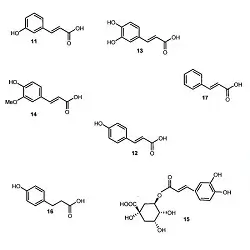Phenylpropanoids:
 Phenylpropanoids are an enormous and fascinating group of organic compounds found in plants. They’re accountable for a dazzling array of scents, colors, and flavors that make the plant world vibrant and diverse. From the fiery red chili pepper to the delicate sweetness of a strawberry, phenylpropanoids are the antioxidants, pigments, and defense mechanisms that provide plants their unique character.
Phenylpropanoids are an enormous and fascinating group of organic compounds found in plants. They’re accountable for a dazzling array of scents, colors, and flavors that make the plant world vibrant and diverse. From the fiery red chili pepper to the delicate sweetness of a strawberry, phenylpropanoids are the antioxidants, pigments, and defense mechanisms that provide plants their unique character.
Building Blocks of Nature:
These versatile molecules are derived from the tyrosine and amino acids phenylalanine. Through a series of enzymatic reactions, plants change these simple building blocks into a stunning array of more complex structures. This “phenylpropanoid pathway” is one of the most significant metabolic pathways in plants, playing a vital role in their development, growth, and survival.
Functions:
Phenylpropanoids have a variety of functions within plants. Some of the most notable are as follows:
Pigmentation: They give vegetables, fruits, and flowers their lively colors, attracting pollinators and aiding in seed dispersal.
Flavor and aroma: They add to the unique taste and smell of many vegetables, fruits, and spices.
Defense mechanisms: They act as natural fungicides and pesticides, protecting plants from pathogens and herbivores.
UV protection: They absorb harmful ultraviolet radiation, protecting plants from sun damage.
Stress response: They help plants cope with environmental stresses, such as cold temperatures and drought.
Beyond the Plant Kingdom:
The usefulness of phenylpropanoids extends far beyond the plant species. These versatile compounds are used in a variety of industries, including:
Food and beverage: They’re used as natural food sweeteners, colorings, and flavorings.
Cosmetics: They’re used in lotions, sunscreens, and perfumes for their antioxidant and anti-inflammatory properties.
Medicine: They’re being studied for their potential use in treating Alzheimer’s disease, cancer, and other chronic diseases.
Final thoughts:
We are constantly discovering new and exciting applications for these remarkable molecules. Apart from their role in plant biology to their potential in human health and industry, phenylpropanoids offer a glimpse into the unbelievable diversity and potential of the natural world.
Plant based Oils and seeds:
